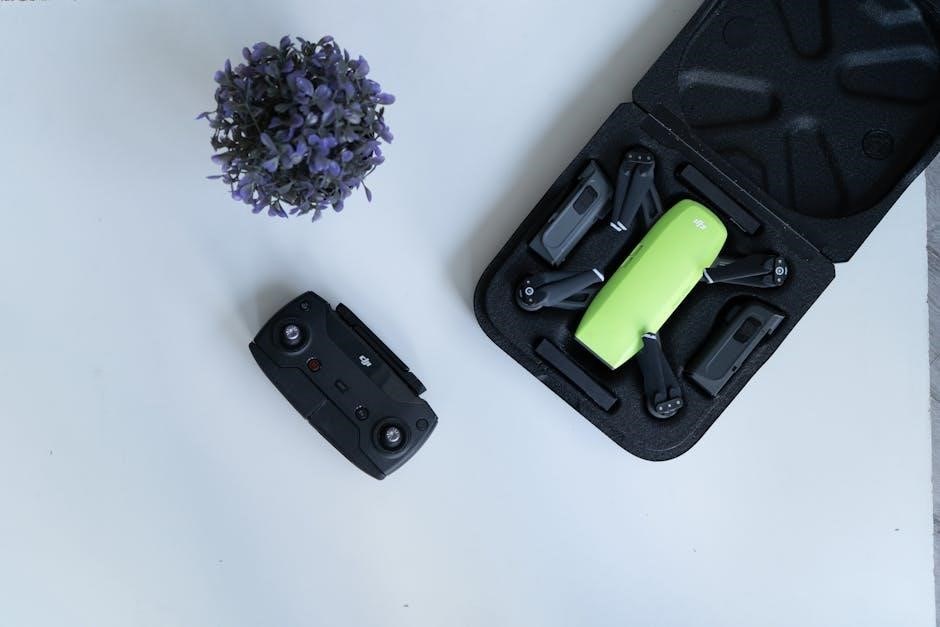
The 6-in-1 Solar Robot Kit is an innovative STEM educational toy that allows users to build six different robots powered by solar energy. Designed for kids aged 8-12, it combines hands-on learning with renewable energy concepts, fostering creativity and critical thinking through interactive assembly and experimentation.
Overview of the Kit and Its Features
The 6-in-1 Solar Robot Kit is a versatile and educational DIY kit that allows users to build six different robot models, each with unique functionalities. Designed for STEM learning, it introduces concepts of robotics and renewable energy through hands-on assembly. The kit includes a solar panel, gears, motors, and other components, enabling users to create models like the TurtleBot, BeetleBot, and UFO Robot. Suitable for children aged 8-12, it promotes creativity and problem-solving skills. The kit is accompanied by a detailed instruction manual, ensuring a smooth assembly process. Its solar-powered design emphasizes sustainability, teaching users about the benefits of renewable energy. This kit is both entertaining and educational, making it an ideal gift for kids interested in science and technology.
Importance of the Instruction Manual
The instruction manual is an essential component of the 6-in-1 Solar Robot Kit, serving as a comprehensive guide for assembling and understanding the various robot models. It provides clear, step-by-step instructions, making it accessible for both beginners and experienced builders. The manual ensures that users can navigate the assembly process confidently, avoiding potential mistakes. Detailed diagrams and written explanations help clarify complex steps, while also introducing fundamental concepts of robotics and solar energy. Additionally, the manual highlights safety precautions and troubleshooting tips, making it an invaluable resource for a smooth and enjoyable building experience. By following the manual, users can fully explore the kit’s creative possibilities and gain a deeper understanding of STEM principles.
Educational Value for STEM Learning
The 6-in-1 Solar Robot Kit offers exceptional educational value, making it an ideal tool for STEM (Science, Technology, Engineering, and Mathematics) learning. By assembling and operating the robot, users gain hands-on experience with mechanical engineering, electronics, and renewable energy concepts; The kit introduces fundamental principles of solar power, gear systems, and motion mechanics, fostering critical thinking and problem-solving skills. It encourages creativity and innovation, allowing users to experiment with different robot configurations. The iterative process of building, testing, and refining models mirrors real-world engineering practices. This kit is particularly beneficial for students, providing a engaging way to explore STEM disciplines while developing teamwork and analytical abilities. It bridges theory and practice, making complex concepts accessible and fun.

Safety Precautions and Tools Needed
Ensure safety by wearing protective gear and avoiding sharp edges. Use tools like screwdrivers, pliers, and Allen wrenches. Keep components away from children and fragile items.
General Safety Guidelines for Assembly
Always wear safety glasses and gloves when handling components to prevent injuries. Work in a well-ventilated area, away from flammable materials. Ensure the solar panel is handled carefully to avoid damage. Check the voltage rating before connecting components. Keep small parts away from children to prevent accidental ingestion. Use tools responsibly and follow instructions to avoid damaging the kit. Avoid over-tightening screws, as this may strip threads. Keep the workspace clean and organized to minimize risks. Never leave assembled robots unattended near water or heat sources. If unsure about any step, consult the manual or seek adult supervision. Prioritize caution to ensure a safe and enjoyable assembly experience.
Handling the Solar Panel and Components
Handle the solar panel with care, as it is fragile and sensitive to scratches. Avoid touching the panel’s surface to prevent grease and dirt buildup, which can reduce efficiency. Use a soft, dry cloth to clean the panel if necessary. When not in use, store the panel in a protective case or wrap it in a soft material. Components such as gears, motors, and wires should be handled gently to avoid damage. Avoid bending or forcing parts into place, as this may cause breakage. Ensure all components are properly aligned before assembly. Use plastic tools instead of metal ones to prevent scratching. Store all parts in a dry, cool place, away from direct sunlight. Always ground yourself before handling electronic components to prevent static discharge. Proper handling ensures longevity and optimal performance of the solar robot kit.
Tools Required for Assembly

To assemble the 6-in-1 Solar Robot Kit, you will need a few basic tools to ensure a smooth and successful build. Start with a small Phillips-head screwdriver for tightening screws and bolts. Pliers or tweezers are essential for handling small components like gears and wires. A pair of diagonal cutters or wire cutters will help trim excess wires. A ruler or measuring tape is useful for aligning parts accurately. Additionally, a small wrench or Allen key may be required for specific bolts. A soldering iron and solder are necessary for connecting electrical components securely. Keep all tools organized in a workspace with good lighting to avoid losing small parts. Having these tools ready will make the assembly process efficient and enjoyable.

Unboxing and Inventory
Unboxing the 6-in-1 Solar Robot Kit is an exciting first step. Carefully unpack the solar panel, gears, frames, wheels, motors, and the instruction manual. Verify all components are included to ensure a smooth assembly process.
Unboxing the 6-in-1 Solar Robot Kit
Unboxing the 6-in-1 Solar Robot Kit is an exciting experience that marks the beginning of your creative journey. Inside the package, you’ll find a variety of components neatly organized, including the solar panel, a set of mechanical parts like gears and frames, wheels, motors, and a comprehensive instruction manual. The kit is designed to be user-friendly, with parts often separated into labeled bags for easy identification. Take your time to carefully unpack each item, ensuring nothing is damaged during transit. This step is crucial for a smooth assembly process. Once everything is out, you’ll have a clear view of the tools and components needed to bring your solar-powered creations to life. Always check for completeness before starting your project.
Checking the Components and Parts
After unboxing, it’s essential to thoroughly inspect and verify all components and parts included in the 6-in-1 Solar Robot Kit. Start by laying out all items on a clean, flat surface and cross-referencing them with the provided parts list in the instruction manual. Ensure that no components are missing or damaged. Key items to check include the solar panel, motors, gears, wheels, frames, and any small hardware like screws or connectors. Inspect the solar panel for any cracks or scratches, as this is crucial for powering the robot. If any parts are damaged or missing, contact the supplier immediately. Once everything is confirmed to be in good condition, you can proceed confidently with the assembly process.

Understanding the Solar Power System
The 6-in-1 Solar Robot Kit uses a solar panel to convert sunlight into electricity, powering its movements and functions. This eco-friendly energy system ensures efficiency and sustainability, making it ideal for STEM projects focused on renewable energy. The solar panel charges a rechargeable battery, storing energy for consistent operation. Understanding how solar energy is harnessed and converted is key to optimizing the robot’s performance. This system not only educates users about solar power but also promotes environmental awareness; Proper alignment and positioning of the solar panel maximize energy absorption, ensuring the robot operates smoothly under various light conditions.
How Solar Energy Powers the Robot
The 6-in-1 Solar Robot Kit operates by converting sunlight into electrical energy through its solar panel. The panel, equipped with photovoltaic cells, captures sunlight and transforms it into power. This energy is then stored in a rechargeable battery, ensuring the robot can function even when sunlight is limited. When the battery is charged, the stored energy is transferred to the robot’s motor, enabling its movements and actions. The solar power system is designed to be efficient, allowing the robot to perform tasks such as walking, rolling, or lifting objects, depending on the model assembled. This renewable energy source makes the robot eco-friendly and sustainable, while also teaching users about the practical applications of solar power in everyday devices.
Optimizing Solar Panel Efficiency
To maximize the performance of your 6-in-1 Solar Robot Kit, ensure the solar panel is positioned at an optimal angle to receive direct sunlight. Clean the panel regularly with a soft cloth to remove dirt or debris that may block sunlight. Avoid placing the robot in shaded areas, as this can significantly reduce energy absorption. For best results, expose the solar panel to full sunlight for at least 6-8 hours before use. If using a rechargeable battery, charge it during the day to store excess energy for cloudy days or indoor operation. Proper alignment and maintenance of the solar panel will enhance efficiency, ensuring consistent power supply to the robot’s motor and components.

Assembly Steps for Beginners
Start by carefully following the instruction manual, sorting parts, and aligning components precisely. Use tools like screwdrivers to secure pieces firmly. Test each step as you progress to ensure functionality. Refer to diagrams for clarity and accuracy during assembly.
Step-by-Step Guide for First-Time Builders
Begin by unboxing and organizing all components. Start with the solar panel, ensuring it is clean and properly connected to the motor. Follow the manual to assemble the base frame, carefully aligning and securing parts with screws. Install the gears and axles, ensuring smooth movement. For each model, refer to the diagram to confirm part placement. Test each step, like motor rotation, before proceeding. Use the provided tools to tighten connections firmly. If building a specific model, focus on its unique features, such as wheels or arms. Double-check alignment to prevent mechanical issues. Finally, test the robot under sunlight to ensure proper function. This methodical approach ensures a successful build for beginners.
Common Mistakes to Avoid During Assembly
Avoid misaligning parts, as this can cause mechanical failures. Ensure gears and axles are properly aligned to guarantee smooth operation. Overlooking the secure tightening of screws can lead to loose connections and potential breakdowns. Neglecting to test each component during assembly may result in unexpected issues later. Failing to follow the provided diagrams accurately, especially for specific models like the ArmBot or WheelBot, can lead to incorrect assembly. Additionally, excessive handling of the solar panel can leave fingerprints, reducing its efficiency. To avoid these pitfalls, proceed methodically, double-check each step, and maintain a clean workspace; Patience and attention to detail are crucial for a successful and functional assembly of your 6-in-1 Solar Robot.

Building the Different Robot Models
Building the six models—TurtleBot, BeetleBot, UFO Robot, WalkerBot, WheelBot, and ArmBot—each offers unique features, teaching various engineering principles in an engaging, hands-on way, fostering creativity and problem-solving skills.
Model 1: The TurtleBot
The TurtleBot is the first model to build, designed to introduce users to the basics of solar-powered robotics. It features a simple, compact design with a slow and steady movement pattern, making it ideal for beginners. The TurtleBot relies on the solar panel to charge its battery, which powers two motors connected to wheels. Assembly involves attaching the motors to the chassis, securing the wheels, and connecting the solar panel. This model teaches fundamental concepts like gear ratios and solar energy conversion. Its slow movement allows for easy observation of how solar power translates to mechanical motion. Troubleshooting tips include ensuring proper alignment of the wheels and checking the solar panel’s angle for optimal energy absorption. Building the TurtleBot is an excellent way to grasp the essentials of robotics and renewable energy, inspiring further exploration of the kit’s capabilities.
Model 2: The BeetleBot
The BeetleBot is the second model in the 6-in-1 Solar Robot Kit, offering a more dynamic and complex design compared to the TurtleBot. It features a beetle-inspired structure with a unique walking mechanism that mimics the movement of an insect. Assembly involves attaching legs and a central axis to create a walking motion powered by the solar panel. This model introduces users to more advanced concepts like gear systems and mechanical linkages. The BeetleBot’s design emphasizes balance and coordination, as its legs must be properly aligned for smooth operation. Tips for assembly include ensuring tight connections between components and testing the walking motion under direct sunlight for optimal performance. Building the BeetleBot enhances problem-solving skills and provides a deeper understanding of solar-powered mechanisms.
Model 3: The UFO Robot

The UFO Robot is the third model in the 6-in-1 Solar Robot Kit, featuring a unique circular design that resembles a flying saucer. This model introduces a new level of complexity with its rotating mechanism, which creates a spinning motion when powered by sunlight. Assembly involves attaching a central motor, gears, and a circular frame with legs. The UFO Robot teaches users about rotational motion and gear ratios, essential concepts in mechanical engineering. To ensure smooth operation, align the gears precisely and secure all components firmly. Testing under direct sunlight is recommended for maximum efficiency. Building the UFO Robot enhances spatial reasoning and mechanical understanding, making it a fun and educational project for enthusiasts of all ages.
Model 4: The WalkerBot
The WalkerBot is an engaging model from the 6-in-1 Solar Robot Kit, designed to mimic a four-legged walking creature. To assemble it, start by gathering all WalkerBot-specific components, including the main body, legs, motors, and gears. Attach the motors to the body frame, ensuring proper alignment for optimal functionality. Next, connect the legs to the body using the provided joints, allowing for the necessary up-and-down motion. Secure the gears to transfer motion from the motors to the legs, ensuring they mesh correctly for smooth operation. Finally, connect the solar panel and circuit to power the motors. Test the WalkerBot under direct sunlight, adjusting the solar panel as needed for consistent movement. This model offers a fascinating insight into mechanical locomotion and renewable energy application.
Model 5: The WheelBot
The WheelBot is a versatile model from the 6-in-1 Solar Robot Kit, designed to demonstrate wheeled motion. Begin by attaching the wheels to the main axle, ensuring they are securely fastened. Next, assemble the body frame and attach the motors to the base plate. Connect the wheels to the motors using the provided gears, making sure they align properly for smooth rotation. Mount the solar panel and circuit board on the top of the body, ensuring they are positioned for optimal sunlight exposure. Once assembled, place the WheelBot in direct sunlight to test its movement. This model is ideal for understanding how solar energy converts into mechanical motion and offers insights into basic robotics and gear systems.
Model 6: The ArmBot
The ArmBot is the final model in the 6-in-1 Solar Robot Kit, showcasing a robotic arm with movable joints. To assemble, attach the motorized arm components to the base plate, ensuring proper alignment. Secure the gears and joints to enable smooth motion. Connect the solar panel and circuit board, positioning them for maximum sunlight absorption. The ArmBot demonstrates how solar energy powers mechanical movements, simulating industrial robotic arms. This model is excellent for learning about gear systems and mechanical advantage. Test the arm’s motion by exposing it to sunlight and observe how the gears translate solar energy into movement. Troubleshooting tips include checking gear alignment and ensuring all parts are securely fastened. This model encourages hands-on learning about robotics and renewable energy applications.

Troubleshooting and Maintenance
Troubleshoot issues like non-moving parts or dim LED lights by checking connections and solar panel alignment; Clean dust from panels regularly for optimal performance. Inspect gears for obstructions and ensure all parts are securely assembled. If problems persist, refer to the instruction manual for detailed solutions. Regular maintenance ensures longevity and efficiency of the robot kit. Always handle components with care to avoid damage. Proper storage and cleaning are essential for maintaining functionality. Addressing issues promptly prevents further complications and keeps the robot operational. Follow these steps to ensure smooth performance and extend the lifespan of your solar robot kit.
Identifying and Fixing Common Issues

Common issues with the 6-in-1 Solar Robot Kit include malfunctioning motors, misaligned gears, or poor solar panel performance. If the robot doesn’t move, check for proper gear alignment and ensure the solar panel is exposed to direct sunlight. Weak movement may indicate faulty motor connections or insufficient power. Inspect wiring for loose joints and ensure the solar panel is clean. Gears may jam due to improper assembly; disassemble and realign if necessary. LED lights not working could signal incorrect polarity or damaged components. Refer to the manual for circuit diagrams and troubleshooting guides. Addressing these issues promptly ensures optimal performance. Always test components individually to isolate faults. Regular inspections can prevent such problems, ensuring smooth operation of your solar-powered robot models.
Cleaning and Maintaining the Solar Panel
Regular cleaning and maintenance of the solar panel are crucial for maximizing energy efficiency. Use a soft, dry cloth to gently wipe away dust, dirt, or debris from the panel’s surface. For stubborn stains, dampen the cloth with distilled water, but avoid harsh chemicals or abrasive materials. Never touch the panel surface with bare hands, as oils can leave residue. Store the robot in a cool, dry place when not in use to prevent humidity damage. Inspect the panel regularly for cracks or broken cells and replace it if necessary. Proper maintenance ensures optimal solar energy absorption, keeping your robot operational and efficient. Cleaning every 1-2 weeks is recommended, especially in dusty environments. This routine will extend the lifespan of your solar panel and ensure consistent performance.
The 6-in-1 Solar Robot Kit offers a comprehensive guide for building and learning. It encourages creativity, STEM education, and hands-on experience. Perfect for beginners and hobbyists alike, this kit fosters innovation and experimentation, providing endless fun while teaching renewable energy concepts. With proper care and maintenance, your solar-powered robots will continue to inspire and educate. Happy building and exploring the endless possibilities of solar robotics!
Building the 6-in-1 Solar Robot Kit involves a step-by-step process that transforms individual components into functional robots. Start by unboxing and inventorying all parts, ensuring nothing is missing. Follow the manual’s clear instructions, beginning with the solar panel setup and progressing through gearbox assembly. Each model—TurtleBot, BeetleBot, UFO Robot, WalkerBot, WheelBot, and ArmBot—requires specific part configurations. Use the provided tools to secure motors, attach wheels, and connect gears. Pay attention to alignment and tightness to ensure smooth operation. Troubleshoot any issues by checking connections and gear meshes. Proper assembly ensures optimal performance, allowing you to harness solar energy efficiently. Patience and attention to detail are key to completing each model successfully. This process fosters problem-solving skills and a deeper understanding of mechanical and solar-powered systems.
Encouraging Creativity and Exploration
Building the 6-in-1 Solar Robot Kit is not just about following instructions—it’s an opportunity to spark creativity and curiosity. Each model offers a unique design, allowing users to experiment with different mechanisms and functionalities. Exploring how solar energy powers the robots introduces learners to renewable energy concepts. Encourage users to think beyond the manual by modifying designs or combining parts creatively. This kit fosters problem-solving skills and innovation, making it an excellent tool for STEM education. By experimenting with various builds, users gain hands-on experience with engineering principles. Troubleshooting challenges during assembly helps build resilience and critical thinking. The kit’s versatility inspires users to explore endless possibilities, turning a simple assembly project into a gateway for imaginative learning and discovery.






